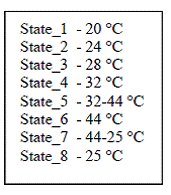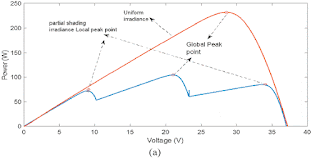ABSTRACT:
Nowadays battery is used to stabilize the DC bus voltage
but battery has low power density and high energy density. Whereas the
supercapacitor has high power density but low energy density. So, for high
energy and power density the integration of battery and supercapacitor is more
efficient. It is more challenging to integrate the different sources. So it is required
a control strategy to integrate the battery and supercapacitor and provide
continuous power to the load. It has also shown that the battery and
supercapacitor charged in access mode of power and discharged in deficit mode
of power. In this paper proposed a new approach to control the power and dc bus
voltage.
1.
Battery
2.
MPPT Controller
3.
Photo Voltaic Cell
4.
Super capacitor
Fig.1. Hybrid system model of PV, Battery and Super capacitor
EXPECTED SIMULATION RESULTS:
Fig.2. DC Bus voltages across two terminals using conventional controller
Fig.3. DC Bus voltages across two terminals using proposed controller
Fig.4. Power consumed by the load using conventional controller
Fig.5. Power consumed by the load using proposed controller
Fig.6. Power sharing between different sources using conventional Controller
Fig.7. Power sharing between different sources using proposed controller
Fig.8. SOC of Battery
Fig.9. Battery Voltage
Fig.10. Battery Current
Fig.11. SOC of Super capacitor
Fig.12. Voltage of Super capacitor
Fig.13. Current of Super capacitor
REFERENCES:
[2]
B. H. Nguyen, R. German, J. P. F. Trovao, and A. Bouscayrol, “Real-time energy management
of battery/supercapacitor electric vehicles based on an adaptation of
pontryagin’s minimum principle,” IEEE Trans. Veh. Technol., vol. 68, no.
1, pp. 203–212, 2019.
[3]
Z. Cabrane, M. Ouassaid, and M. Maaroufi, “Battery and supercapacitor for
photovoltaic energy storage: A fuzzy logic management,” IET Renew. Power
Gener., vol. 11, no. 8, pp. 1157– 1165, 2017.
[4]
H. R. Pota, M. J. Hossain, M. A. Mahmud, and R. Gadh, “Control for microgrids
with inverter connected renewable energy resources,” IEEE Power Energy Soc.
Gen. Meet., vol. 2014-October, no. October, pp. 27–31, 2014.
[5]
S. Angalaeswari, O. V. G. Swathika, V. Ananthakrishnan, J. L. F. Daya, and K.
Jamuna, “Efficient Power Management of Grid operated MicroGrid Using Fuzzy
Logic Controller (FLC),” Energy Procedia, vol. 117, pp. 268–274, 2017.








































